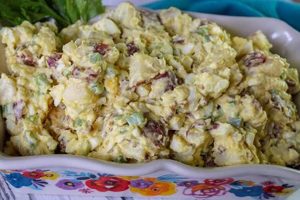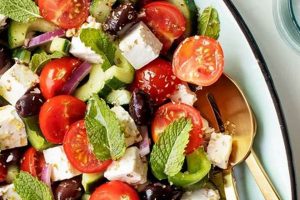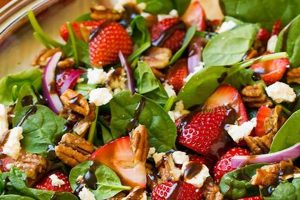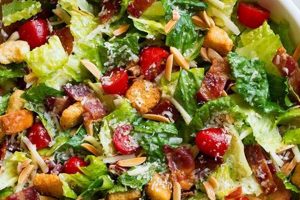A guide to preparing a shredded cabbage-based salad featuring characteristically Asian flavors typically involves a vibrant mix of fresh vegetables, a flavorful dressing often built on soy sauce, vinegar, sesame oil, and ginger, and sometimes includes additional ingredients like nuts, seeds, or dried fruits. Variations are numerous, ranging from light and tangy slaws to more substantial salads incorporating proteins like chicken or tofu.
These salads offer a refreshing and healthy meal option, rich in vitamins, minerals, and fiber. The diversity of ingredients allows for a wide spectrum of flavor profiles, catering to different palates and dietary needs. From ancient culinary traditions to modern fusion cuisine, the combination of crisp vegetables and savory-sweet dressings has remained a staple in many Asian cultures, reflecting the emphasis on fresh, balanced meals.
This discussion will delve deeper into variations on this culinary theme, explore specific ingredient combinations and their origins, and provide practical guidance for creating delicious and authentic Asian cabbage salads at home.
Tips for Creating Exceptional Cabbage Salads
Achieving optimal flavor and texture in a cabbage salad requires attention to detail throughout the preparation process. These tips offer guidance for elevating the final dish.
Tip 1: Cabbage Selection and Preparation: Opt for fresh, firm heads of cabbage. Napa or Savoy cabbage varieties offer delicate textures, while regular green cabbage provides a more robust crunch. Thinly slice or shred the cabbage for optimal texture and flavor absorption.
Tip 2: Enhancing Flavor through Salting: Salting the shredded cabbage and allowing it to rest draws out excess moisture, resulting in a crisper texture and concentrated flavor. Rinse and thoroughly dry the cabbage before adding other ingredients.
Tip 3: Dressing Versatility: Explore a range of flavor profiles by experimenting with different dressings. Classic combinations include rice vinegar, soy sauce, sesame oil, and ginger. Additions like chili garlic sauce, fish sauce, or lime juice can add complexity and depth.
Tip 4: Balancing Sweet and Savory Elements: A harmonious balance of sweet and savory components is crucial. Achieve this balance by adjusting the proportions of sugar, vinegar, and salty ingredients like soy sauce or fish sauce.
Tip 5: Incorporating Textural Variety: Add contrasting textures with ingredients such as toasted sesame seeds, chopped peanuts, crispy fried onions, or slivered almonds. These additions enhance the overall sensory experience.
Tip 6: Protein Integration: Elevate the salad into a complete meal by incorporating grilled chicken, shrimp, tofu, or edamame. Ensure the protein complements the chosen dressing and other ingredients.
Tip 7: Fresh Herb Enhancement: Fresh cilantro, mint, or Thai basil can provide a bright, aromatic lift to the salad. Add these just before serving to maintain their vibrancy.
By following these tips, one can create cabbage salads that are not only flavorful and visually appealing but also offer satisfying textural contrasts and nutritional value.
These guidelines provide a solid foundation for crafting a diverse array of cabbage salads, from simple everyday meals to impressive dishes for special occasions.
1. Fresh Cabbage
Fresh cabbage serves as the foundational ingredient in Asian cabbage salads, contributing significantly to the overall texture, flavor, and nutritional value. Understanding cabbage varieties and proper handling techniques is essential for creating a successful dish.
- Variety Selection
Different cabbage varieties offer unique characteristics. Napa cabbage, with its delicate, crinkled leaves, lends a mild sweetness and tender texture. Regular green cabbage provides a more robust crunch and slightly peppery flavor. Savoy cabbage, with its ruffled leaves, offers a balance between the two. Choosing the appropriate variety influences the final salad’s character.
- Quality and Freshness
Selecting fresh, firm heads of cabbage is paramount. Look for vibrant color, crisp leaves free from blemishes or wilting. Proper storage, ideally in a refrigerated environment, maintains freshness and prevents premature spoilage. The quality of the cabbage directly impacts the salad’s overall quality.
- Preparation Techniques
Proper preparation enhances both texture and flavor. Thinly slicing or shredding the cabbage creates a desirable texture and increases surface area for dressing absorption. Techniques like salting and resting the shredded cabbage draw out excess moisture, resulting in a crisper final product. These steps contribute significantly to the salad’s overall appeal.
- Nutritional Contribution
Cabbage provides essential vitamins, minerals, and dietary fiber. It is a good source of Vitamin C, Vitamin K, and folate, contributing to the salad’s nutritional value. Incorporating fresh cabbage promotes a healthy and balanced meal.
The selection, quality, preparation, and inherent nutritional benefits of fresh cabbage directly influence the final outcome of an Asian cabbage salad. By understanding these aspects, one can create a dish that is not only flavorful and texturally appealing but also nutritionally sound. The choice of cabbage variety and its careful handling are fundamental steps towards a successful and satisfying culinary experience.
2. Vibrant Vegetables
Beyond cabbage, the inclusion of other vibrant vegetables significantly contributes to the complexity, nutritional value, and aesthetic appeal of Asian cabbage salads. These additions introduce contrasting textures, colors, and flavors, transforming a simple cabbage base into a multifaceted culinary experience. The careful selection and preparation of these supporting vegetables are crucial for a well-balanced and visually appealing final product.
- Color and Visual Appeal
Vibrant vegetables enhance the aesthetic appeal of the salad. Carrots, bell peppers (red, yellow, or orange), and red onions introduce contrasting colors against the backdrop of green cabbage, creating a visually stimulating dish. This visual appeal enhances the dining experience and adds to the perceived freshness of the salad.
- Textural Contrast
Different vegetables contribute varied textures, creating a more engaging sensory experience. Shredded carrots provide a gentle sweetness and a slightly firm texture, while thinly sliced bell peppers offer a crisp, juicy bite. The interplay of these textures alongside the cabbage creates a dynamic mouthfeel, enhancing overall enjoyment.
- Flavor Enhancement
The inclusion of other vegetables expands the flavor profile of the salad. The sweetness of carrots complements the peppery notes of cabbage, while the sharp bite of red onion adds a pungent layer. These complementary flavors create a more balanced and nuanced taste experience.
- Nutritional Value
Adding a variety of vegetables increases the nutritional density of the salad. Carrots are rich in Vitamin A and beta-carotene, bell peppers provide Vitamin C, and red onions offer antioxidants. This combination of nutrients contributes to a healthier and more balanced meal.
The incorporation of vibrant vegetables elevates the Asian cabbage salad from a simple dish to a complex and nutritionally rich culinary creation. The interplay of colors, textures, and flavors creates a symphony of sensations, enriching the dining experience. These additions are not merely decorative but contribute significantly to the overall balance and nutritional value of the salad, solidifying its place as a healthy and satisfying meal option.
3. Flavorful Dressing
The dressing serves as the unifying element in an Asian cabbage salad, binding the diverse vegetables and other components together while imparting a distinctive character. A well-crafted dressing elevates the salad beyond a simple combination of ingredients, transforming it into a cohesive and flavorful dish. The balance of sweet, sour, salty, and umami notes within the dressing is crucial for achieving a harmonious and satisfying culinary experience.
- Foundation of Flavor
The dressing forms the flavor foundation of the salad. Common bases include soy sauce, rice vinegar, and sesame oil. These ingredients provide a savory backdrop upon which other flavors can be built. The quality of these base ingredients significantly impacts the overall taste profile of the dressing and, consequently, the entire salad.
- Balancing Flavor Profiles
A successful Asian cabbage salad dressing achieves a delicate balance between sweet, sour, salty, and umami. This balance can be achieved by adjusting the proportions of ingredients like sugar, vinegar, soy sauce, and fish sauce. The interplay of these contrasting flavors creates a complex and nuanced taste experience, enhancing the overall appeal of the salad.
- Enhancing Complexity and Depth
Additional ingredients introduce layers of complexity and depth to the dressing. Ginger, garlic, chili flakes, and toasted sesame seeds contribute distinct aromatic and textural notes. These additions enhance the sensory experience and create a more sophisticated flavor profile. The judicious use of these ingredients can transform a simple dressing into a culinary masterpiece.
- Cohesion and Harmony
The dressing acts as a unifying element, bringing together the diverse flavors and textures of the salad components. It coats the vegetables, allowing them to absorb the flavors and creating a cohesive culinary experience. The dressing ensures that the individual ingredients work together harmoniously, resulting in a balanced and satisfying dish.
The flavorful dressing is arguably the most critical component of a successful Asian cabbage salad. Its role extends beyond simply adding flavor; it creates harmony, balance, and complexity. The careful selection and combination of ingredients in the dressing determine the overall character and appeal of the salad, transforming individual components into a unified and delicious culinary creation.
4. Optional Protein
While not strictly essential, the inclusion of optional protein significantly enhances the nutritional value and satiety factor of an Asian cabbage salad, transforming it from a side dish into a complete meal. The choice of protein and its preparation method should complement the other salad components, creating a harmonious balance of flavors and textures. Understanding the role and implications of adding protein provides greater flexibility and allows for customization based on dietary preferences and needs.
- Nutritional Enhancement
Protein adds substantial nutritional value to the salad, providing essential amino acids necessary for muscle building and repair. This addition transforms the salad into a more balanced and complete meal, particularly beneficial for individuals seeking higher protein intake. The choice of protein can be tailored to specific dietary requirements, such as lean chicken breast for lower fat content or tofu for a vegetarian option.
- Increased Satiety
Protein contributes significantly to feelings of fullness and satiety, making the salad a more satisfying meal option. This can be particularly advantageous for those aiming to manage their calorie intake or maintain stable blood sugar levels. The inclusion of protein helps to prevent overeating and promotes sustained energy levels.
- Flavor and Texture Considerations
The chosen protein should complement the existing flavors and textures of the salad. Grilled chicken or shrimp can provide a savory contrast to the fresh vegetables and tangy dressing, while tofu offers a neutral base that readily absorbs the flavors of the dressing and other ingredients. The method of preparation, whether grilling, pan-frying, or steaming, further influences the protein’s contribution to the overall sensory experience.
- Versatility and Customization
The optional nature of protein allows for customization based on individual preferences and dietary restrictions. Options range from animal-based proteins like chicken, shrimp, or beef to plant-based alternatives such as tofu, edamame, or chickpeas. This flexibility allows the salad to cater to a wide range of dietary needs and preferences, enhancing its versatility as a meal option.
The inclusion of optional protein in an Asian cabbage salad represents a significant opportunity to enhance its nutritional profile and create a more satisfying and complete meal. By carefully considering the type of protein, its preparation method, and its interaction with the other salad components, one can create a customized dish that caters to individual needs and preferences while maximizing both flavor and nutritional value.
5. Crunchy Toppings
Crunchy toppings represent a crucial element in Asian cabbage salads, contributing significantly to textural complexity and overall sensory appeal. These additions provide a contrasting element to the softer textures of the cabbage and other vegetables, elevating the salad from simple to sophisticated. The strategic selection and application of crunchy toppings enhance the dining experience and contribute to the dish’s visual appeal.
- Textural Contrast
Crunchy toppings introduce a vital textural contrast to the predominantly soft elements of the salad. This interplay of textures creates a more dynamic and engaging mouthfeel. The contrast between the crispness of the toppings and the softer textures of the vegetables elevates the sensory experience, making each bite more satisfying. Examples include toasted sesame seeds, chopped peanuts, crispy fried onions, or slivered almonds. These provide varying degrees of crunch and contribute to the overall complexity of the salad’s texture.
- Flavor Enhancement
Beyond texture, crunchy toppings often contribute nuanced flavors that complement the overall flavor profile of the salad. Toasted sesame seeds impart a nutty aroma and subtle bitterness, while peanuts offer a richer, more pronounced nuttiness. Crispy fried onions contribute a savory, umami element, and slivered almonds offer a delicate sweetness. These flavors interact with the dressing and other vegetables, creating a more complex and balanced taste experience.
- Visual Interest
Crunchy toppings enhance the visual appeal of the salad by adding contrasting colors and shapes. The sprinkling of sesame seeds, the varied hues of nuts, or the golden strands of fried onions create visual points of interest against the backdrop of the vegetables. This visual appeal enhances the presentation and makes the salad more enticing.
- Nutritional Considerations
Many crunchy toppings contribute additional nutritional value to the salad. Nuts and seeds, for example, are excellent sources of healthy fats, protein, and fiber. While often used in smaller quantities, these additions can contribute to the overall nutritional density of the salad. However, portion control is important, as some crunchy toppings can be calorie-dense.
The incorporation of crunchy toppings in an Asian cabbage salad is a defining characteristic that elevates the dish beyond a simple combination of ingredients. These additions introduce crucial textural contrasts, enhance flavor profiles, contribute visual interest, and often provide additional nutritional benefits. The careful selection and application of crunchy toppings demonstrate attention to detail and contribute significantly to the overall enjoyment and sensory experience of the salad.
Frequently Asked Questions
This section addresses common inquiries regarding Asian cabbage salads, providing concise and informative responses to facilitate a deeper understanding of their preparation and versatility.
Question 1: What type of cabbage is best suited for these salads?
Napa cabbage is often preferred for its delicate texture and mild flavor, but regular green cabbage and savoy cabbage also offer excellent options, providing a more robust crunch. The choice depends on individual preferences and the desired textural outcome.
Question 2: Can the dressing be prepared in advance?
While dressings can be prepared in advance, it’s generally recommended to add them to the salad just before serving to prevent the cabbage from becoming soggy. This preserves the desired texture and prevents the flavors from becoming diluted.
Question 3: How can one prevent the salad from becoming watery?
Salting the shredded cabbage and allowing it to rest for approximately 15-20 minutes draws out excess moisture. Thoroughly rinsing and drying the cabbage before combining it with other ingredients is crucial for maintaining a crisp texture.
Question 4: What are suitable protein additions for a more substantial meal?
Grilled chicken, shrimp, tofu, or edamame are excellent protein additions that complement the flavors of Asian cabbage salads. The choice of protein should align with individual dietary preferences and the overall flavor profile of the salad.
Question 5: How long can these salads be stored in the refrigerator?
Asian cabbage salads are best consumed fresh. However, if storage is necessary, they can be kept in an airtight container in the refrigerator for up to two days. The quality and texture may degrade over time.
Question 6: Can these recipes be adapted for different dietary needs?
The inherent versatility of Asian cabbage salads allows for easy adaptation to various dietary needs. Gluten-free versions can be achieved by using tamari or coconut aminos in place of soy sauce. Vegan options are readily available by omitting animal-based proteins and ensuring all other ingredients are plant-derived.
Understanding these key aspects of preparation and storage contributes to a more successful and enjoyable culinary experience with Asian cabbage salads. These insights provide a foundation for exploring the diverse possibilities within this culinary tradition and tailoring recipes to individual preferences.
This concludes the FAQ section. Further exploration of specific regional variations and detailed recipe instructions follows.
Asian Cabbage Salad Recipes
Exploration of Asian cabbage salad recipes reveals a versatile culinary landscape. From the foundational role of fresh cabbage to the nuanced interplay of vibrant vegetables, flavorful dressings, optional proteins, and crunchy toppings, each component contributes to the overall sensory experience. Careful consideration of ingredient selection, preparation techniques, and flavor balancing ensures a successful outcome. Adaptability to various dietary needs and preferences further solidifies the position of Asian cabbage salads as a versatile and healthful meal option.
The enduring popularity of these salads underscores their significance within various culinary traditions. Continued exploration and experimentation with diverse ingredients and flavor profiles promise further evolution and innovation within this vibrant culinary realm. An understanding of the core principles presented herein empowers culinary enthusiasts to create and appreciate the multifaceted nature of Asian cabbage salads.






